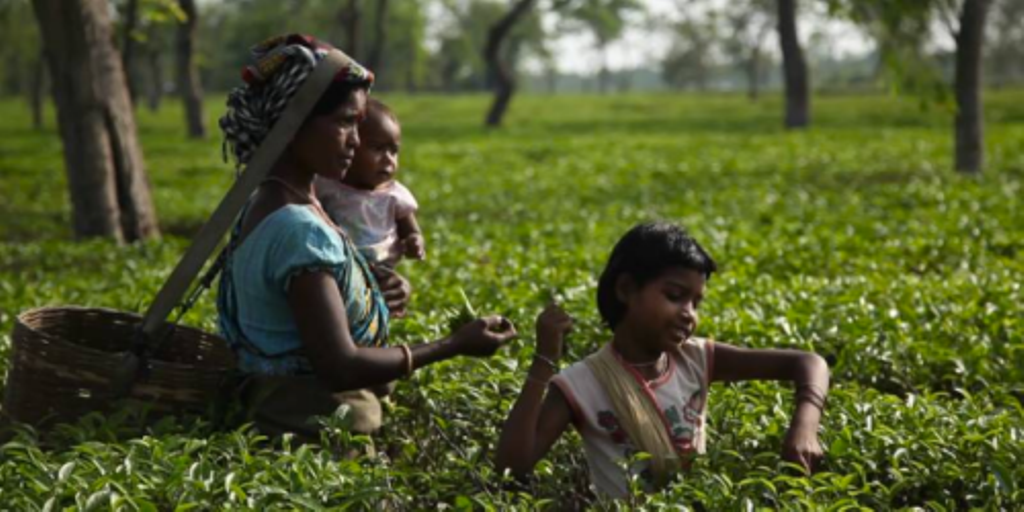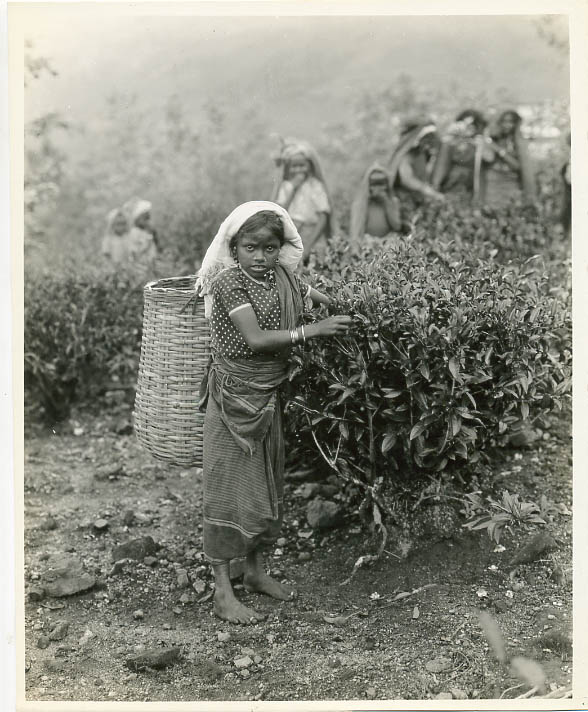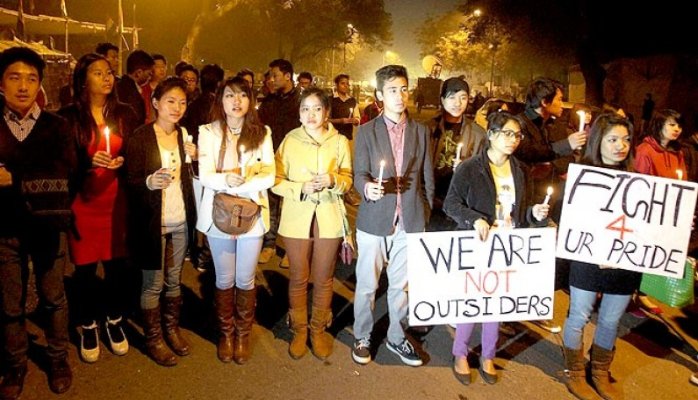From Ranbir Kapoor trying to woo Ileana D’Cruz in Baarfi, to Rajesh Khaana singing Mere Sapno Ki Rani Kab Aayegi Tu for Sharmila Tagore in Aradhana, the feudal romance of the Bengali planters in the backdrop of tea plantations of the hilly Darjeeling is understood as a legacy of the colonial rule. The whistle of the toy train and the smoke of the rail engines revealing the picturesque slopes covered in green carpets of tea bushes, with pahari women clad in red and carrying bamboo baskets on their heads promptly picking up “the two leaves and a bud”, looking up at the camera to give a coy smile— these variegated images, carefully projected through films and advertisements, loom large when India imagines Darjeeling. Saif Ali Khan daydreaming about Vidya Balan as a tea garden worker in the song Kasto mazaa hai railei ma is the quintessential romanticised stereotype of the worker in the hills.

Stereotyping Darjeeling: Screenshot of Kasto Mazaa Hai – from Parineeta Movie
But the story of Darjeeling is not in the songs and in Bollywood feudal romances. In fact, it lies the untold history of violence that has been erased from official memory but is remembered in the deepest of living memories, protected from the outsiders to “save” the “Queen of hills”.
Carceral culture in tea plantations
These picturesque plantations, in reality, emerged as Foucauldian open prison-houses, where the regime of “discipline” and “fear” was preserved through chiefly the North Bengal Mounted Rifles, maintained by the plantation owners. Upon the instruction of the planters, constables from the rifle either beat up the labourers (sometimes to death) or threw his/her entire family outside the plantation under the Hatta Bahira system — a mechanism to penalise the worker by exiling his/her whole family from the plantation over some “misconduct”.

Modern Day Feudalism: The tea garden model actively promotes bonded-labour like set up to this day
Summing up the rank exploitation in the tea plantations, Sushil Kumar Subba, a resident of the Margaret’s Hope Tea Garden, recounts with a look of deep melancholy: “My parents worked during the British time. Even after independence, the goras were in control(the manager was called Auckland) of the garden. During British era, it was all in all[the exploitation was extreme]. We had to listen to whatever they said. If someone did not, they would be chucked out and it was called hatta bahira. Money paid by them was too meagre. I remember my mother getting 1 anna, which is 6 paise. Then slowly it came up to 4 anna, that is 25 paise. In their time, there was no gratuity or provident fund. She retired without any provisions for pension.”
Even though the British left India, the British planters did not leave the tea plantations of Darjeeling. With independence, everyone, including the workers, hoped for a better India, free of exploitation. But India as a nation failed miserably to improve the condition of the tea plantation workers. Their exploitation continued as before when they worked directly under the oppressive colonial regime. In fact, the newly formed Indian government aided the planters in maintaining the same colonial “control” over the workers, which can be termed “carceral culture” (to use the Foucauldian analogy). Distraught by the situation, a huge rally was organised in Margaret’s Hope Tea Estate on June 25, 1955. This demonstration was an outburst against the rank abuse of the tea plantation workers, jointly carried out by the British planters and the newly independent nation-state of India. The rally was part of a days-long strike called from June 22, 1955.
Labour woes in Margaret’s Hope
Margaret’s Hope is situated in the wilderness of the Himalayas, near a quaint town called Kurseong. History has it that earlier this tea garden was named Bara Rington and was owned by one Mr. Bagdon from England, who had sailed to the garden along with his two daughters. Here, the younger daughter fell ill and succumbed to her illness during her journey back home to England. It is in the memory of his younger daughter Margaret, that Bagdon renamed the garden as “Margaret’s Hope”.
It was the year 1955. “I still remember the eventful day of June 25…”, Sushil bajje recollects, “… an andolan happened”. This andolan is revered in the hills as the first time when tea plantation workers collectively asserted their rights for better working conditions and a share in the earnings, believing in the nascent dream of a newly independent country. A 14-point “Charter of Demand” was submitted to the government, which included maternity leave for women, bonus, abolition of the Hatta Bahira system, increase in wages and other statutory benefits for the workers, which was hitherto unheard of in the tea plantations. Despite various attempts, the government showed no intention of accepting their charter of demands.
Then, a series of strikes started on June 22. The presence of leaders like Ratanlal Brahmin, often referred to as Maila bajje, Dr Talapatra, Sushil Chatterjee, DeoprakashRai and other such leaders belonging to the Communist Party of India (CPI) and Akhil Bhartiya Gorkha League (ABGL) played a very instrumental role in organising the workers. The CPI and ABGL jointly called the strike. The call for a strike led to the arrest of many labour leaders and the activists.
Exploiting women and children
Unlike other industries, tea plantations tend to have a huge female workforce, that has been contributing to the plantation both productively and reproductively. On one hand, women workers were being structurally discouraged and brought down in industries like jute, cotton, etc., while on the other, there was a mammoth increase of women labourers in the tea plantations. The trend of decrease in women workers in other industries went hand in hand with the campaign for labour rights, such as the Factories Act, maternity leaves, etc. (Sen, 2008). Women and children had been employed as cheap labour but when rights specific to women were being implemented, the management needed to incur certain extra costs on women which made them an “expensive” labour option.

The Brits promoted Child Labour in the Tea Gardens [via: Columbia.edu]
June 25, 1955: Shaheed Diwas
Remembering that momentous day, Sushilbajje says: “I was in the hostel. My parents were here in the garden. A huge rally was organised. A number of workers from other kamaans (tea gardens) joined in. The rally was very big. There was a gigantic crowd, seen from down the control (ration shop) to all the way uphill. The police were all standing at the control dara to attack the workers. The workers at the back got agitated. They broke down the police barracks. In a nearby tea garden, coolies were forced to work. The aim of the rally was to stop the coolies from working. Something happened somewhere; some say someone must have thrown a stone and the police started firing into the unarmed crowd.”
“Twenty-five people were injured and six died on the spot. Among them, one was a pregnant woman. ShaeedDiwas is celebrated every year on June 25 in their name. One young boy from our dara also got killed in the rally. He was my friend, Kaley Limbu, who was younger than me. He died near the control where he had climbed up a tree to see the rally. He was technically not a part of it. It is said that he was eating cheura on the treetop while watching the rally when the police fired at him. He was all of fourteen. He fell down from the tree and died on the spot.”

Continued Colonialism: Those killed in “Independent India” for demanding better wages – One of them was a pregnant woman. The wages of tea garden workers in Darjeeling, Terai and Dooars is still pitiable
Angered by the ruthlessness of the State, the next day many more from the adjoining tea plantations of Terai and Dooas joined the strike and collectively marched to Darjeeling town. They ghearoed the district headquarters. They were angry at the police of young Indian who did not hesitate to fire on the civilians. However, the management had to finally give in to the collective assertion of the workers. Bonus was given for the first time after the protest.
‘A worker’s life was worth some paisa’
“The wage was increased by some paisa. The Father of my school called me and said: ‘Chhe insaan maryo, alik paisa roj bhoruyo. Ek admi ko jaanko dam aite paisa ho’. [Six people died and some paisa was increased. The worth of one person’s life is few paisa].” Sushil bhajje said, matter-of-factly.
“The bodies were taken to Darjeeling in order to avoid further mobilisation. It is said that they were buried near the prison. This andolan was an outburst against all the oppressions. I was returning from school and had taken the road below. I was carrying a bag with school books. There were police everywhere. I was stopped by the police. They asked me few questions in Hindi and I knew very little Hindi. I told them that I stay here and I am coming from the hostel. They checked my bags and found nothing except books. They asked me to leave and in a threatening tone, told me to tell my parents not to go for any rally, if there was any to happen. The police had surrounded the whole garden and nobody left their house for a few days. When I returned to the school, the Father showed me the newspaper in which the news about the six deaths had come. That is the time he said:‘Ek paisa ho aaj, ek zindagi ko dam’ [Today, the worth of a life is 1 paise].”
This is how the 1955 struggle ushered in the beginning of labour movements in the hills of Darjeeling.
The struggle continues
Till date, the tea plantation workers of Darjeeling continue to fight for fair wages. Under the ambit of the Plantation Labour Act, 1951, they are paid a mere Rs159, when the minimum wage of a non-skilled worker is Rs 226; for the semi-skilled worker it is Rs 248; and a skilled worker it is Rs 273. Other clauses of the Plantation Labour Act, 1951 are violated with impunity.
Many plantations have closed down arbitrarily, leaving several out of jobs and practically starving. Lack of employment is driving the young out of the town in search of opportunities, which remain limited and plagued by racial discrimination. Those who continue to stay in the plantations, struggle everyday to figure out basic necessities such as water, healthcare and transport.

Children of Tea Garden Workers in Dooars forced to pluck tea flowers to substitute for vegetables
Suresh Rai, a father of two children and a plantation worker says: “We are like puppets in the world. When you buy dolls for our children, they throw them away when the dolls get old. Our lives are similar to those old ragged dolls. As long as we are healthy, we are of use. The moment we become ill, then our existence becomes meaningless for the maliks. We need to be healthy. We can’t afford to get sick. It drains us and our family completely. And all my prayer is that if we have to die, we will die, but we should not fall ill. If we fall ill then the entire house suffers. Even after that if people recover it’s fine, but if they die after some illness, it is even worse. Debts have to paid with interest. Even houses are not spared. They too are sold off to repay our maliks, who still won’t give us a paisa more.”
For further reading, please visit: Happy May Day – Historic Labour Movement of 1955 of Margaret’s Hope Tea Garden
……………………………..
We are most grateful to the author Kritika A and Editor Angshukanta for permitting us to republish this article. This article was originally posted in TheLeaflet.in






Leave a comment